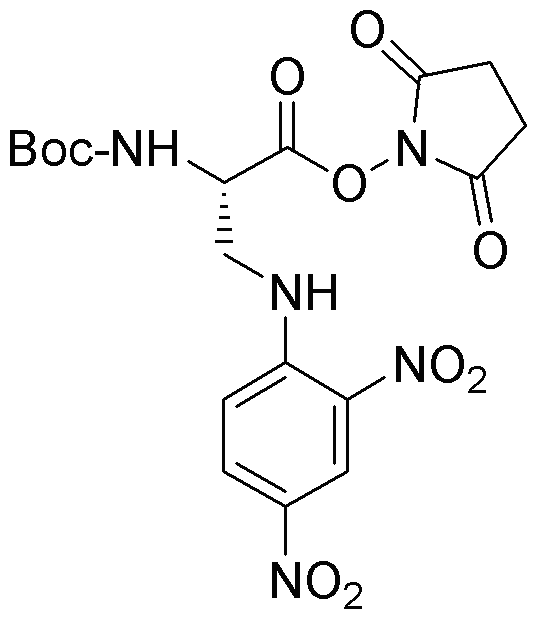Na-Boc-Nb-2,4-dinitrophenyl-L-2,3-diamino-propionic acid N-hydroxyuccinimide ester is widely utilized in research focused on:
- Peptide Synthesis: This compound serves as a valuable reagent in the synthesis of peptides, allowing for the introduction of specific amino acid sequences. Its unique structure enhances the efficiency of coupling reactions, making it a preferred choice for researchers in biochemistry.
- Drug Development: In pharmaceutical research, it plays a role in the development of novel drug candidates. Its ability to modify amino acids can lead to improved bioavailability and targeted delivery of therapeutic agents.
- Bioconjugation: The compound is used in bioconjugation processes, where it helps attach biomolecules to surfaces or other molecules. This application is crucial in creating targeted therapies and diagnostic tools in the medical field.
- Fluorescent Labeling: It can be employed in fluorescent labeling techniques, aiding in the visualization of proteins and other biomolecules in cellular studies. This enhances the understanding of biological processes and disease mechanisms.
- Diagnostics: The compound is also relevant in the development of diagnostic assays, particularly in immunoassays where specific binding interactions are crucial. Its properties facilitate the creation of sensitive and accurate diagnostic tools.
General Information
Properties
Safety and Regulations
Applications
Na-Boc-Nb-2,4-dinitrophenyl-L-2,3-diamino-propionic acid N-hydroxyuccinimide ester is widely utilized in research focused on:
- Peptide Synthesis: This compound serves as a valuable reagent in the synthesis of peptides, allowing for the introduction of specific amino acid sequences. Its unique structure enhances the efficiency of coupling reactions, making it a preferred choice for researchers in biochemistry.
- Drug Development: In pharmaceutical research, it plays a role in the development of novel drug candidates. Its ability to modify amino acids can lead to improved bioavailability and targeted delivery of therapeutic agents.
- Bioconjugation: The compound is used in bioconjugation processes, where it helps attach biomolecules to surfaces or other molecules. This application is crucial in creating targeted therapies and diagnostic tools in the medical field.
- Fluorescent Labeling: It can be employed in fluorescent labeling techniques, aiding in the visualization of proteins and other biomolecules in cellular studies. This enhances the understanding of biological processes and disease mechanisms.
- Diagnostics: The compound is also relevant in the development of diagnostic assays, particularly in immunoassays where specific binding interactions are crucial. Its properties facilitate the creation of sensitive and accurate diagnostic tools.
Documents
Safety Data Sheets (SDS)
The SDS provides comprehensive safety information on handling, storage, and disposal of the product.
Product Specification (PS)
The PS provides a comprehensive breakdown of the product’s properties, including chemical composition, physical state, purity, and storage requirements. It also details acceptable quality ranges and the product's intended applications.
Certificates of Analysis (COA)
Search for Certificates of Analysis (COA) by entering the products Lot Number. Lot and Batch Numbers can be found on a product’s label following the words ‘Lot’ or ‘Batch’.
*Catalog Number
*Lot Number
Certificates Of Origin (COO)
This COO confirms the country where the product was manufactured, and also details the materials and components used in it and whether it is derived from natural, synthetic, or other specific sources. This certificate may be required for customs, trade, and regulatory compliance.
*Catalog Number
*Lot Number
Safety Data Sheets (SDS)
The SDS provides comprehensive safety information on handling, storage, and disposal of the product.
DownloadProduct Specification (PS)
The PS provides a comprehensive breakdown of the product’s properties, including chemical composition, physical state, purity, and storage requirements. It also details acceptable quality ranges and the product's intended applications.
DownloadCertificates of Analysis (COA)
Search for Certificates of Analysis (COA) by entering the products Lot Number. Lot and Batch Numbers can be found on a product’s label following the words ‘Lot’ or ‘Batch’.
*Catalog Number
*Lot Number
Certificates Of Origin (COO)
This COO confirms the country where the product was manufactured, and also details the materials and components used in it and whether it is derived from natural, synthetic, or other specific sources. This certificate may be required for customs, trade, and regulatory compliance.


